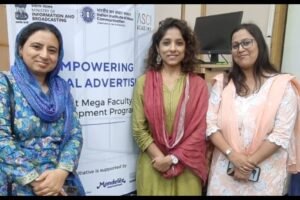
Say Hello to Media Literacy ! Debunk the fake and misinformation
Media literacy is extensively debated, but its understanding in India is still questionable. The ability to critically evaluate, analyze, and understand the information presented through various media outlets news reports, social media posts, videos, and commercials—is the cornerstone of media literacy. It encompasses examining the credibility of sources, detecting biases, and distinguishing between facts and misinformation. In the modern age of digitalization, in which information travels quickly, it is necessary to be media literate in order to make informed decisions and steer clear of the ill effects of misinformation and propaganda. In its absence, individuals risk being misled by false narratives, propaganda, and sensationalism, and public perception could be altered to the detriment of society.
Also Read:- Nap Smarter, Not Harder: The Sleep Hacking Revolution of 2025
Fake News and India
India has witnessed an increase in misinformation, leading to real violence, political polarization, and societal anxiety. According to a Microsoft survey in 2019, 64% of Indians were exposed to fake news on the internet, the highest rate among 22 countries surveyed. One of the most infamous examples is the 2018 WhatsApp lynching incidents, where mass rumors about child kidnappers led to mob attacks, killing over 30 innocent people. Investigators later found that the allegations were entirely baseless.
In 2024, a deepfake video of a Bollywood actor allegedly making inflammatory remarks went viral, triggering public outrage. However, fact-checking platforms like Alt News and Boom Live revealed that the video was doctored through deepfake technology. Another example is the false claim during the 2024 elections that EVMs (Electronic Voting Machines) could be hacked, which was denied by the Election Commission of India.
Also Read:- AI + Data Journalism = सच्चाई की सबसे तेज रिपोर्टिंग!
According to DataLEADS, nearly 80% of Indians do not fact-check news before sharing, making them susceptible to false news. Social media platforms like WhatsApp, Facebook, and X (formerly Twitter) are the primary sources for becoming vulnerable to disinformation. Social media platforms like WhatsApp, Facebook, and X (formerly Twitter) are the main sources for becoming vulnerable to fake news because of their fast-forward sharing systems. The absence of media literacy makes it worse since many users cannot tell the difference between doctored photos, sensational headlines, or artificially generated information.
Why Media Literacy Matters
Media literacy allows citizens to:
- Identify misleading or falsified information.
- Verify information from reputable sources.
- See through motives of viral disinformation (political, monetary, or sensationalism).
Efforts like Google’s “ShareChat” fact-checking initiative and government initiatives like “PIB Fact Check” are positive moves. But institutionalizing media literacy in school curricula and public outreach campaigns is crucial for sustained change. Workshops, digital literacy campaigns, and partnerships with tech firms can complement India’s efforts to combat disinformation.
In a democracy like India, where rumors can influence minds and lead to violence, media literacy is not only a skill—by necessity, it must be a part of a well-informed society.
Also Read:- GEC Vs OTT Content: The Growth Trajectory of Entertainment Content
How ISOMES is helping in spreading awareness about Media Literacy
At ISOMES, faculty members conduct regular workshops to spread awareness about media literacy. Through regular debates and discussions, students delve deeper into fact-finding and conduct case studies on viral trends. ISOMES also regularly organizes workshops featuring industry experts to help students gain a solid understanding of media literacy. Experienced core faculty members also provide hands-on training in tools and techniques to debunk fake news and misinformation.
Also Watch Our Students Projects:-



